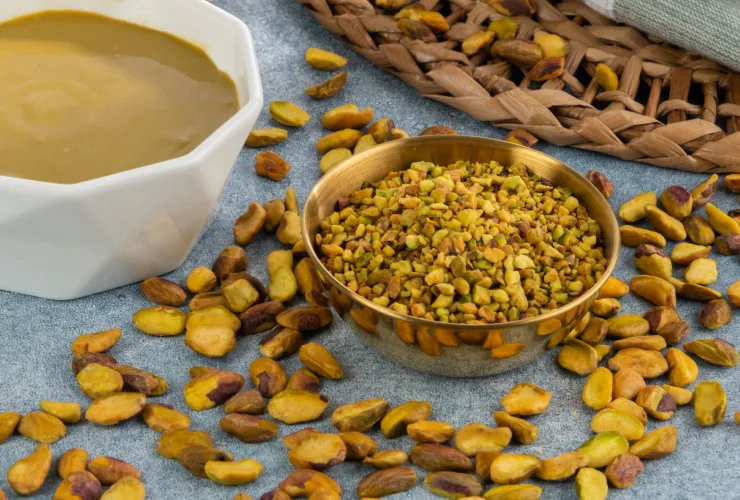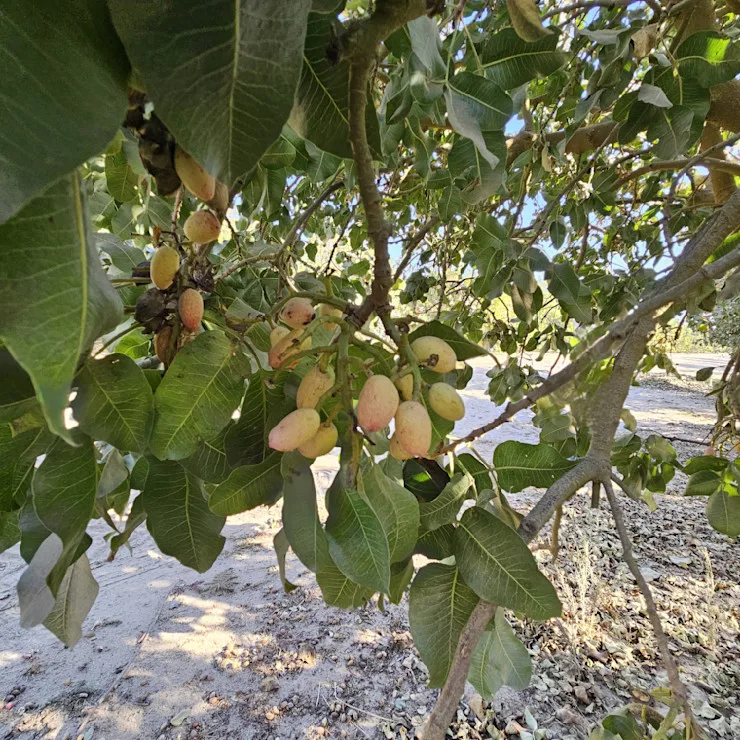Collaboration
Our food scientists and R&D team are here to bring your pistachio ideas to life, transforming them into unique, market-ready products that will leave a lasting impression.
Pistachios are the emeralds of the nut world, with their striking green color and satisfying crunch. It’s not just their vibrant hue that makes them special, though—it’s that beautiful balance of sweet and nutty flavor in every bite. A creamy delicious pistachio smoothie or a tangy salad dressing made from pureed pistachios is hard to resist.
And consumers know it, with pistachio-flavored treats gaining in popularity all the time. Creamy pistachio gelatos, rich lattes and decadent pastries are fan favorites. All that, and they’re healthy too. Packed with protein, fiber and healthy fats, they provide a nourishing energy boost and an easy, guilt-free indulgence. It’s no wonder they’ve earned a spot as a staple in the wellness world.
Passionate about pistachios? We can help. We grow our pistachios in California's San Joaquin Valley, where hot summers, mild winters, fertile soil and advanced irrigation systems create the ideal environment for producing high-quality, high-yield pistachios. And we pass that quality on to your products.
The pistachio is a versatile powerhouse able to bring flavor and satisfying texture to a wide range of foods and beverages.
At ofi, our expertise in pistachio production and cutting edge facilities allows us to create customized solutions for you, whatever your needs, in convenient sizes and formats. Thanks to our advanced custom processing, we ensure that each product retains its natural flavor and nutrition. From savory dishes to desserts and everything in between, we offer pistachios that fit your needs—whole, chopped, roasted or blended into custom pastes. Dive in to discover how you can harness the joy of this little gem.

Whole pistachios and nut pieces offer a satisfying texture and a delightfully fragrant nutty profile, elevating a wide range of dishes. Whether tossed in fresh salads, baked into rich cookies or added to chocolates, whole pistachios always introduce a distinctive touch and delectable taste.
Our pistachios are available in a variety of forms, including natural, dry roasted, salted, inshell and caramelized options. We also offer them whole, chopped and diced, ensuring the perfect solution for your needs.

Our pistachio footprint has continued to grow, and we now farm over 1200 acres throughout orchards in California, a region that comprises 99% of the entire US pistachio production.
We maintain an extensive sourcing network to help ensure you get a consistent, reliable supply.
Our cracking, roasted and salted inshell pistachios, along with pistachio ingredient processing, are expertly handled at our state-of-the-art facility in Vietnam.

+
acres: the size of our pistachio orchards*
%
of entire US pistachio production comes from California, where our pistachios are grown*
square feet of innovation at our processing plant in Vietnam*
* Numbers are subject to change

Co-create
Looking to impress your customers? How about a pistachio-infused dressing, a smooth pistachio dip perfect for gourmet appetizers, or a pistachio-chocolate energy bar to fuel your health-conscious fans?
Our food scientists and R&D team are here to bring your pistachio ideas to life, transforming them into unique, market-ready products that will leave a lasting impression.
Whether you need suggestions, customization or refining, we’ll work closely with you to create the perfect pistachio-based product your customers will love.

Our processing plant in Vietnam comes with a highly efficient process flow to meet customized specifications, so every order can be calculated with precision. Equipped with advanced color sorters, infrared and x-ray screening, metal detectors and manual sorting, this is state-of-the-art technology for top-quality pistachios.
At ofi, we see huge potential for creativity with pistachios—beyond snacking. Whether it’s pioneering rich, creamy pistachio milk or crafting protein-packed functional bars, the opportunities for fresh thinking are endless.